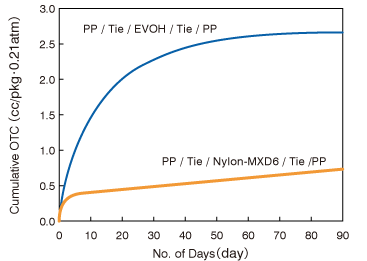Nylon-MXD6/Polypropylene Laminated Containers
Laminated sheets and containers composed of polyolefin and Nylon-MXD6 retain their gas-barrier characteristics after a retorting process. Moreover, any gas-barrier quality reduction caused by retorting will quickly recover. Table 10 shows the change in the oxygen transmission coefficient of retorted laminated containers. Fig. 9 shows the cumulative oxygen transmission coefficient of retorted laminated containers.
| Structure of Laminated Containers | Thickness (µm) | Oxygen Permeation rate (cc/Package ·day· 0.21atm) |
||||
|---|---|---|---|---|---|---|
| Initial | Time after retorting (day) | |||||
| 1 | 7 | 14 | 30 | |||
| PP/Tie/Nylon-MXD6/Tie/PP | 140/10/40/10/180 | 0.047 | 0.38 | 0.028 | 0.020 | 0.019 |
| PP/Tie/EVOH/Tie/PP (Ethylene 32mol%) |
140/10/40/10/180 | 0.012 | 0.68 | 0.49 | 0.25 | 0.11 |
Fig. 9 Cumulative Oxygen Transmission Coefficient of Nylon-MXD6/Polypropylene Laminated Containers after Retorting

EVOH : ethylene 32moi%
Retorting Conditions : 121℃, 30min
Container Specifications Volume : 350cm3
Surface Area : 310cm2
(Inside)PP / Tie / Nylon-MXD6 / Tie / PP(Outside)
140/10/40/10/180µm (average)
Measuring Conditions:23℃, 100%RH (Inside), 50%RH (Outside)
Inquiries Concerning Products
Green Energy & Chemicals Business Sector
High-performance Products Division
HP Material Department
TEL:+81-3-3283-4800 / FAX:+81-3-3214-0938
